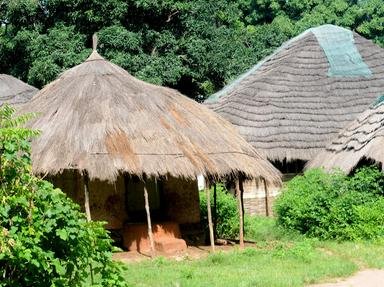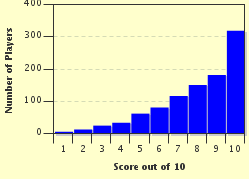Quiz Answer Key and Fun Facts
1. These names sure can be confusing. Which of the following 'Guinea' countries shares a border with the Republic of Guinea?
2. What geometric shape does the Republic of Guinea resemble?
3. The flag of Guinea features the same colors as the flag of Ghana, but with vertical rather than horizontal stripes, and without the central black star. What are the national colors of the Republic of Guinea?
4. One of the major rivers of Africa has its origins in the Republic of Guinea, before running eastwards through Mali and Niger, along the border of Benin, and through Nigeria before reaching the Gulf of Guinea. Which river is this?
5. The Republic of Guinea is thought to have between a quarter and a half of the world's reserves of a mineral which is very useful as a source for the metal aluminum. Which ore is mined extensively in northwest Guinea, and forms one of the country's major exports?
6. The coastal lowlands of the Republic of Guinea (an area called Lower Guinea) are part of an eco-region called the Guinean forest-savanna mosaic which extends through at least ten west African nations. This eco-region provides the habitat for a number of animals. Which of these is NOT one of them?
7. Approximately one-fifth of the country of Guinea is the central region referred to as Fouta Djallon or Futa Jalon. This name comes from the indigenous name for the region in the Fula language, and the name for the original inhabitants, the Jalonke people. How would this region best be described in geographical terms?
8. The northeastern third of the country of Guinea is part of a large savanna referred to as Upper Guinea, which extends into the neighboring countries of Sierra Leone, Liberia and Cote d'Ivoire. What kind of vegetation would you expect to find in this area?
9. The southeastern quarter of the Republic of Guinea is called Forested Guinea. The region's largest city, Nzerekore, more than doubled in size between 1995 and 2008. What caused this massive population increase?
10. What is the official name for the dry trade wind nicknamed 'the Doctor' which blows through Guinea and other West African countries between November and March? It can have a harmful impact on local activities.
Source: Author
looney_tunes
This quiz was reviewed by FunTrivia editor
Pagiedamon before going online.
Any errors found in FunTrivia content are routinely corrected through our feedback system.

